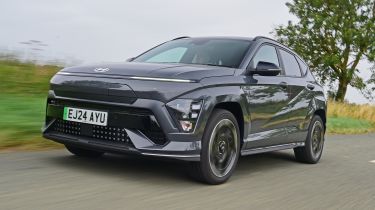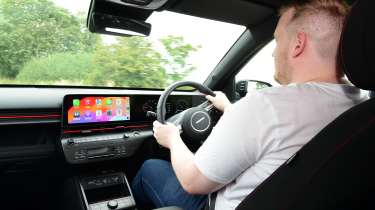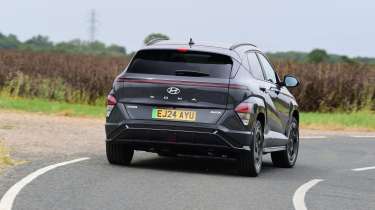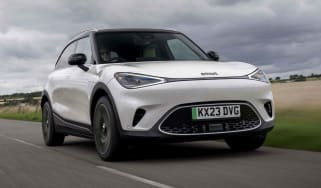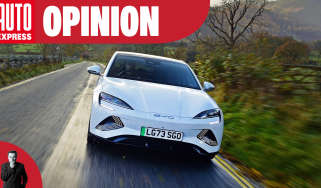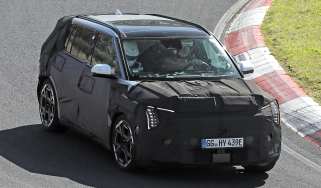Hyundai Kona Electric N Line review: not as exciting as its looks suggest
N Line trim brings more kit and some sporty design tweaks to Hyundai’s sensible small SUV, but it isn’t any sharper to drive

Verdict
The N Line treatment doesn’t make the Hyundai Kona Electric any more powerful or sportier to drive, but so long as you know that going in then you won’t be disappointed. The highly accomplished EV is a great all-rounder with a stand-out interior that’s spacious, well-built and functional. It’s also refined and very efficient too, just not as exciting as the looks of this particular version might suggest.
The incredibly well-rounded Mk2 Hyundai Kona scored a hat-trick of wins in our New Car Awards last year, including the coveted title of Auto Express Car of the Year. But in our eyes the golden child of the range has always been the Kona Electric, and now it's available in N Line specification which is designed to inject some sporty flair into the sensible and mature electric car.
The big change for the Kona Electric N Line is its mean-looking body kit that includes more aggressive bumpers front and rear, new side skirts and a bespoke set of 19-inch rims. Meanwhile inside, there are sport seats with the N Line logo and red contrast stitching, an N Line steering wheel with more red stitching, extra red accents across the dashboard and air vents, and aluminium pedals.
Used - available now
That’s your lot. Like with the petrol and hybrid Kona, N Line versions only offer styling and interior tweaks – the chassis and powertrain are untouched. There are also none of the novelties you get in the Hyundai Ioniq 5 N, like the synthesised gear changes or soundtrack with all its popping and banging.
Still, the Kona isn’t short on grunt. The single electric motor that drives its front wheels produces what used to be considered hot hatchback levels of power – 215bhp and 255Nm of torque – enough that 0-62mph takes less than eight seconds. Accelerating from a standstill does feel relatively slow by EV standards, but once you’re on the move and you stomp on the throttle, the instant hit of torque can push your head into the headrest.
There’s plenty of grip from the front end and the Kona handles quick changes in direction without fuss, so it’s a very stable car through the corners, but not a very exciting one.
The Kona has a four-stage regenerative braking system that you can quickly adjust the strength of using the paddles on the steering wheel. It includes a proper one-pedal driving mode that we found isn’t only good for pottering around town, but is strong enough that you don’t need to touch the brake pedal when driving in the twisties as well.
We recommend utilising this as much as possible, as we found when the regen is completely off that the physical brakes require a lot of force before the car really starts to slow down, and the Kona can dive under heavy braking.
Because the suspension hasn’t been tweaked for the N Line version, the ride is still forgiving and comfortable, plus refinement is great. We covered more than 400 miles testing this car, mostly on motorways, and managed to achieve impressive 3.8 miles per kWh. That equates to a real-world range of 245 miles from the 64.5kWh battery – just shy of the claimed 282 miles.
The N Line’s sports seats are not deep racing buckets, but have just enough side bolstering to feel supportive yet still comfortable on longer journeys. The black, grey and red colour scheme does make the interior feel a little gloomy, and the heavy use of hard, black plastics on the doors and dashboard doesn’t help. But build quality overall is very impressive as everything feels tightly screwed together, and we’re always going to applaud a brand for continuing to feature physical climate controls and switchgear in its cars.
Hyundai’s latest infotainment system is still a cut above most rivals’ as well, and is capable of an enormous array of functions, although it is perhaps too clever for its own good. Finding settings involves navigating through several menus, particularly when it comes to the driver assistance and safety systems.
It makes turning off the various bongs and chimes very tricky, not to mention distracting, and because it’s all handled by the touchscreen this process then sets off the driver attention warning. The speed limit warning is also very eager to tell you off, and difficult to silence.
It’s a very first world problem and one that isn’t exclusive to the Kona or Hyundais, but competitors like Skoda and Renault have come up with solutions that make it far easier to turn these systems off, if the driver chooses to.
Prices for the Kona Electric N Line start from £40,395, or £1,800 more than the equivalent Advance-spec model. It gets all those styling tweaks and long-range battery as standard, plus dual 12.3-inch displays, wireless Apple CarPlay and Android Auto, keyless entry, ambient lighting, front and rear heated seats, a heated steering wheel, wireless smartphone charger and a powered boot lid.
Then there’s N Line S trim, which ups the price to £43,095. It adds Alcantara and leather upholstery, heated and ventilated seats, a Bose sound system, full-width front light bar and surround view camera system, among other driver aids. Reserved for this trim is an optional £2,150 Lux Pack that piles on more luxuries, including an electric sunroof and remote park assist.
| Model: | Hyundai Kona Electric N Line |
| Price: | £40,395 |
| Powertrain: | 64.5kWh battery, 1x e-motor |
| Power/torque: | 215bhp/255Nm |
| Transmission: | Single-speed auto, front-wheel drive |
| 0-62mph: | 7.8 seconds |
| Top speed: | 107mph |
| WLTP range: | 282 miles |
| Charging: | 41 mins (102kW, 10-80%) |
| Dimensions (L/W/H:) | 4,385/1,825/1,580mm |
| On sale: | Now |

